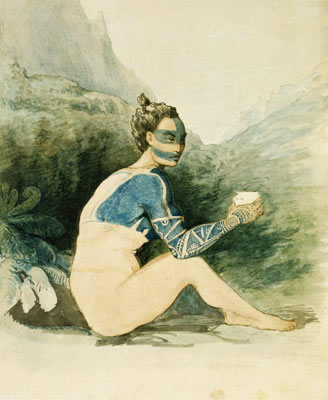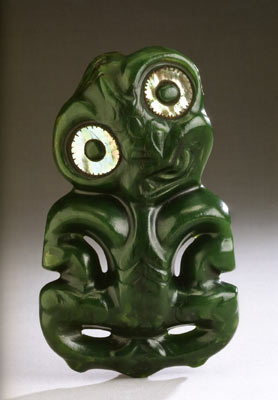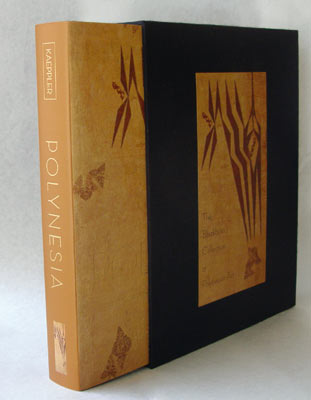Book celebrates art of Polynesia

"Woman of the Marquesas Islands," from 1838, is a watercolor painting by Ernest-Auguste Goupil, official artist of the voyage of the Astrolabe and Zelee from 1837 to 1840.

This 18th-century Maori hei tiki, a greenstone and paua shell amulet, was probably carved without the use of metal tools, based on the fracture patterns.

"Polynesia: The Mark and Carolyn Blackburn Collection of Polynesian Art," with chapter essays by Adrienne L. Kaeppler (University of Hawaii Press, $100; special limited-edition, signed copies, $150)



|
Mark Blackburn’s fascination with all things Polynesia began as a lad of 13, when he read an abridged account of Capt. James Cook’s Pacific voyages.
His later travels to New Zealand, Tahiti and Hawaii further fueled his interest. Now, 40 years after purchasing his first artifact at a flea market in Hamburg, Germany, Blackburn and his wife, Carolyn, have amassed one of the most significant and comprehensive private collections of Oceanic artifacts.
"We are serious collectors," said Blackburn, who owns Mauna Kea Galleries on South King Street with his wife.
The couple decided to share approximately 1,000 of their pieces in Adrienne Kaeppler’s new book, "Polynesia: The Mark and Carolyn Blackburn Collection of Polynesian Art." The 448-page book was designed by award-winning local designer Barbara Pope and includes 804 color illustrations and photographs.
Don't miss out on what's happening!
Stay in touch with breaking news, as it happens, conveniently in your email inbox. It's FREE!
MEET THE AUTHOR AND COLLECTORS» Launch event, 6 to 8 p.m. Thursday, Native Books/Na Mea Hawaii, Ward Warehouse. Includes a talk and weaving, kapa, carving and feather-work demonstrations by cultural practitioners Solomon Apio, Gwen Kamisugi, Lorna Pacheco, Ka’iulani De Silva, Michael Mauricio, Umi Kai and Kuahiwi Lorenzo. Call 597-8697. » Book signing, 11 a.m. to noon Saturday, Honolulu Academy of Arts gift shop. Call 532-8703. » Lecture and reception, 2 to 3 p.m. next Sunday, East-West Center Gallery, Burns Hall, 1601 East-West Road. Call 944-7612.
|
A special launch event with the Blackburns and Kaeppler, and featuring cultural practitioners, will be held from 6 to 8 p.m. Thursday at Native Books/Na Mea Hawaii in Ward Warehouse.
On display in "Polynesia: The Mark and Carolyn Blackburn Collection of Polynesian Art" are sculptural pieces, paintings, photographs, bark cloth, paddles and clubs, drums, tools, bowls, weapons and more, many having associations with Cook’s 18th-century explorations and Kamehameha the Great; Adm. du Petit-Thouar, who was instrumental in France’s 19-century annexation of the Marquesas; Queen Pomare of Tahiti; and Chief Cakobau of Fiji.
"This is probably the best private collection of Polynesia in the world," Kaeppler said. "They are not just outstanding pieces, but representative objects. It’s very unusual for a private collector to look for so many different things."
Essays in the book focus on more than a dozen island or island groups including Fiji, Samoa, Tonga, the Marquesas and Cook islands, Rapa Nui and Hawaii. Among Kaeppler’s favorites in the collection is a Tongan ivory figure.
"There are only a few in the world. At the Tongan exhibition (of the collection), the king and many other people had not seen the figure before," she said.
KAEPPLER IS CURATOR of Oceanic ethnology at the Smithsonian Institution in Washington, D.C., and also worked at Bishop Museum in the 1970s. She earned her undergraduate and graduate degrees at the University of Hawaii.
Blackburn maintained files on each of the objects in his collection. "I was familiar with the items, but oftentimes he noted where he had bought it and its provenance, which is the important part of this book," Kaeppler said.
The two worked together in Tonga in 1998 when they set up the special exhibition for the opening of the Tonga National Museum on the 80th birthday of King Taufa’ahau Tupou IV.
"We lent out objects all over the world," Blackburn said. The items in the collection have been shown at New York’s Metropolitan Museum of Art and throughout Europe. "A lot of our stuff is constantly traveling. And that’s how we want it — it was meant to be shared.
"The collection is a part of our everyday lives," he said. "It’s not under lock and key. Since Polynesian culture has been such a passion for me, I wanted to give the artifacts a wider audience."
Blackburn has a hard time choosing a favorite, but when pressed leans toward Maori pieces because of their expressiveness. "Hawaiian sculptural pieces are also rare," he said.
The book is intended to inform scholars and lay people alike. "It really allows people to get a feel for the Polynesian culture. If it wasn’t for early collectors, much of this material would not have survived," he said.
Blackburn will travel to Australia next month to give talks on the "Polynesia" book at the National Gallery of Australia and the Art Gallery of New South Wales.



